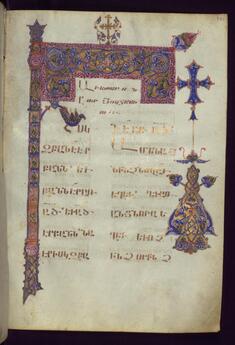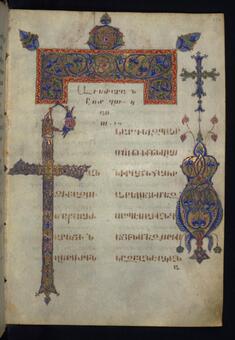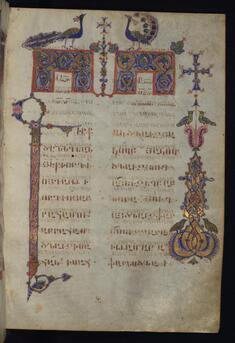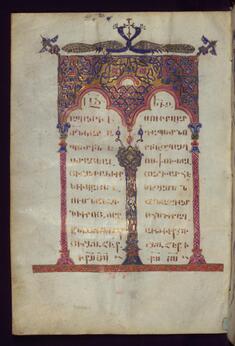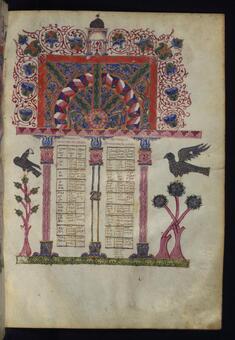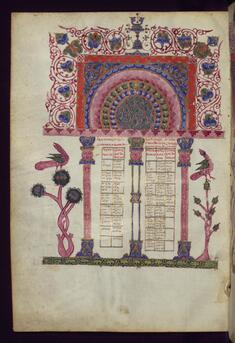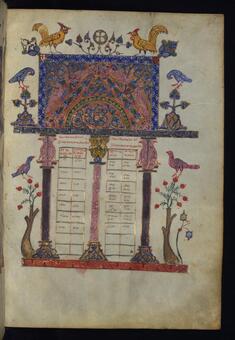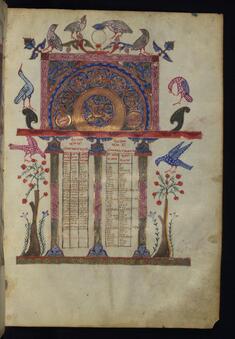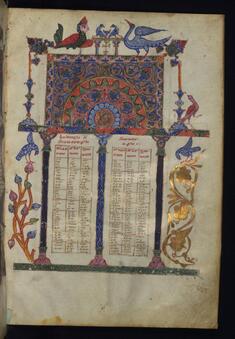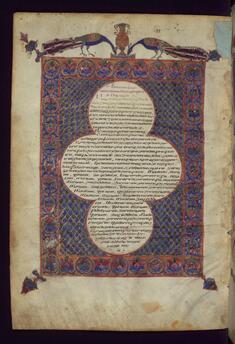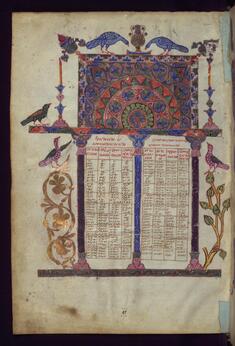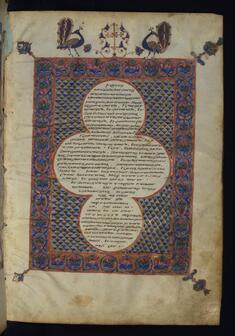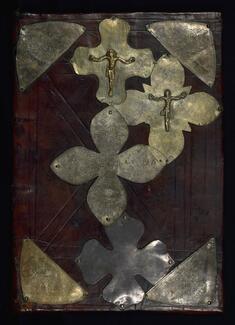Gospels
(Manuscripts and Rare Books, Medieval Europe )
This manuscript was produced at the end of the katholicate of Grigor IV (Tay) at the monastery of Pawoskan in Cilicia. The principal colophon on fols. 311r-313v dates the manuscript to 1193 CE (642 AE), and the patron, Bishop Karapet, a resident at the court of Grigor at Hromkla, is recorded in the dedication on fol. 12v. The colophon also records the siege of Jerusalem by Saladin in 1187, the Third Crusade (1189-1192) and Frederick Barbarossa's attempt to reclaim Palestine, and Barbarossa's death in 1190. The Canon Tables and the Eusebian letter within quatrefoil frames are decorated with architectural elements, geometric designs, floral motifs, and birds. The codex is further illuminated with historiated and inhabited initials forming the incipits of the Gospels and marginal decoration.
Provenance
Provenance (from the French provenir, 'to come from/forth') is the chronology of the ownership, custody, or location of a historical object. Learn more about provenance at the Walters.
Commissioned by Bishop Karapet for the Monastery of Pawloskan (modern Kozan, Türkiye), 1193. Catholicos John VI [Katholikos Ohannes (Yovhannes or ?????????) VI of the Holy See of Cilicia], Hromkla (modern Rumkale, Türkiye), before 1221, [mode of acquisition unknown]; Smbat (nephew of Catholicos John VI), Hromkla (modern Rumkale, Türkiye), 1221, by gift. Khodja Hovannes (Yohannes), between 14th and 18th centuries, by gift. Monastery of T'umay A?ak'eal (Apostle Thomas), between 14th and 18th centuries, by donation. Gevork', son of Nazluxan [Knazlu Khatun], 1770, [location and mode of acquisition unknown]; Ter Hohannes, late 18th-early 19th century, by gift [location unknown]. In New Nakhijevan (modern Rostov-on-Don, Russia), before 1889 to after 1903 [1]. Henry Walters, Baltimore, by 1931 [mode of acquisition unknown] [2]; Walters Art Museum, 1931, by bequest.
[1] The location of the manuscript is unknown between 1903 and 1931, and it may have been removed from Armenian territory at some point during World War I and the Armenian Genocide.
[2] Possibly acquired from Dikran Kelekian, New York and Paris, ca. 1930, according to a letter in the Walters Art Museum Archives from Dikran Kelekian to Dorothy Miner dated 12 December 1945. In the letter, however, certain details are confused with W.539.
Exhibitions
| 2016-2017 | Jerusalem 1000–1400: Every People Under Heaven. The Metropolitan Museum of Art, New York. |
| 2010-2011 | Beasts on Parchment: Picturing Animals in Medieval Manuscripts. The Walters Art Museum, Baltimore. |
| 2007 | Armenie: La Magie d'Ecrit. Centre de la Vieille Charité, Marseille. |
| 2004 | Illuminating the Word: Gospel Books in the Middle Ages. The Walters Art Museum, Baltimore. |
| 2001 | Treasures from the Ark: 1700 Years of Armenian Christian Art. British Library, London. |
| 1994 | Treasures in Heaven: Armenian Illuminated Manuscripts. The Morgan Library & Museum, New York; The Walters Art Gallery, Baltimore. |
| 1988 | Treasures in Heaven: Armenian Manuscript Illumination. The Walters Art Gallery, Baltimore. |
| 1984-1985 | Illuminated Manuscripts: Masterpieces in Miniature. The Walters Art Gallery, Baltimore. |
| 1947 | Early Christian and Byzantine Art. Baltimore Museum of Art, Baltimore. |
Conservation
| Date | Description | Narrative |
|---|---|---|
| Loan Consideration | examined for loan | |
| 9/20/1987 | Examination | examined for loan |
| 8/30/2016 | Treatment | binding stabilized; examined for loan; media consolidation; splits mended |
Geographies
Turkey, Cilicia, Poghoskan (Armenia) (Place of Origin)
Measurements
Overall H: 10 13/16 x W: 7 7/8 x D: 2 15/16 in. (27.5 x 20 x 7.5 cm); Folio H: 10 3/8 × W: 7 5/16 in. (26.4 × 18.5 cm)
Credit Line
Acquired by Henry Walters
Location in Museum
Not on view
Accession Number
In libraries, galleries, museums, and archives, an accession number is a unique identifier assigned to each object in the collection.
In libraries, galleries, museums, and archives, an accession number is a unique identifier assigned to each object in the collection.
W.538




